By Kate Hosford & Cynthia Levinson
for Cynthia Leitich Smith's Cynsations

Earlier this week, we interviewed each other about our respective new circus-themed book releases.
Don't miss
the interview about Cynthia's
Watch Out for Flying Kids! How Two Circuses, Two Countries, and Nine Kids Confront Conflict and Build Community (Peachtree, 2015) or
the interview about Kate's
Feeding the Flying Fanellis and Other Poems from a Circus Chef, illustrated by
Cosei Kawa (Carolrhoda, 2015).
Here's our final installment of this series:
Why do you think circus arts—and books about them—have become so popular with kids?Kate: I think circus arts fill a need that wasn’t being met in our culture. American kids who wanted to be physical usually turn to team sports, but if kids want an outlet that is both physical and artistic, they need to look elsewhere.
 |
| Kate |
Circus arts are athletic and artistic and also provide kids with an opportunity for healthy escapism. The circus world is magical and mysterious, and by participating in circus arts, children are able to ‘run away with the circus’ before returning to their regular lives.
For kids who serious about circus arts, another benefit is that their troupe really functions as family. They are united in trying to put on the best show possible, and in many cases have also entrusted their physical safety to their fellow troupers or to crew members.
I think your book makes it very clear that the bonds that are forged through this interdependence are profound, especially if the circus is comprised of kids from different cultures who can not always fall back on a shared language as a form of communication.
Ultimately, the circus family cannot function unless each member is fully focused and committed, and this is true whether you are a performer, director, crew member, or the circus chef.
Cynthia: Kids’ lives today are closely scrutinized, demanding, and competitive. Maybe circus—both real ones and books about them—is especially appealing now because it provides ways for kids to find an alternative to their everyday situations.
 |
| Cynthia |
Unlike the rest of their lives, circus is non-competitive. Performers have to cooperate, partly because that’s the ethos of circus and also because it’s too dangerous not to. So they take big risks but in a supportive environment.
One of my major takeaways from my research into circus is that, while it appears to be exotic, it is actually doable by a wide range of kids. They get to imagine themselves inside a world that is both fantastic and real.
Anyone can truly accomplish what appears to be the impossible.
Many of their peers seek fantasy online or in virtual worlds and compete with each other for grades or recognition. But circus kids help each other create an alternate reality, literally.
I don’t know if this explains why circus is becoming prominent but I hope these values come across in kidlit.
They certainly do in your book where the troupers seem out of this world—but they have to eat, like normal people! And the chef has to be flexible to figure out their very human needs.
By
Kate Hosford for
Cynthia Leitich Smith's
CynsationsCynthia Levinson’s book
Watch Out for Flying Kids! How Two Circuses, Two Countries, and Nine Kids Confront Conflict and Build Community (Peachtree, 2015) is an in-depth look at the world of social circus —a movement that brings kids from different cultures together to perform.
Cynthia follows the story lines of nine kids in two circuses:
Circus Harmony in St. Louis (comprised of suburban and inner-city kids) and
Circus Galilee in Israel (comprised of Jews and Arabs).
As the kids evolve, they must overcome many physical, cultural and emotional obstacles.
Cynthia’s eye for detail, her ability to stay close to her characters, and her tenacity as a researcher makes her writing vivid, suspenseful and utterly compelling.
I couldn’t wait to see how life turned out for each one of these kids, and I’m in awe of her ability to keep all the balls in the air while researching and writing this book.
How did you conduct your research? What were some of your most memorable research experiences? What were some of the obstacles you encountered along the way when writing this book?The
research was a combination of exhilarating, onerous, and hilarious. Exhilarating because I got to spend hundreds of hours
behind the scenes at circuses, seeing how kids learn to plant their feet next to their ears while lying on their stomachs, walk en pointe in toe shoes along a tight wire, and juggle clubs behind their backs.
 |
| Meghan and Hila, contortion |
Also, I spent nine days living with
Jewish and
Arab families in the Galilee. If you’ve heard of Middle-Eastern hospitality, you’ll know what this means. The number of dishes at every meal! The multiple ways of cooking eggplant! The warm pita and fresh hummus! In addition, circus people all over the world pride themselves on welcoming everyone as family.
 |
| Circus Cynthia! |
So, I moved in with the St. Louis troupe, too. All of these experiences were invaluable for immersing myself in the Middle East, the Midwest, and the universe of circus.
The research was also onerous, however, because only four of the nine kids featured in the book live in the United States. One of the Americans was in professional circus school in Canada, and the Israelis, of course, were in Israel. So, I was dealing with three time zones and two foreign languages.
Technology glitches also intervened. When I couldn’t talk with the kids face-to-face, we communicated by whichever means worked best for them—telephone, email, text, Skype or Facebook messaging and video—as long as the devices, the cell towers, and the internet connections worked. When one of those went down, so did the conversation.
Then, there was the fact that they and their coaches—who spoke, variously, Hebrew, Arabic, German, Mongolian or occasionally English—were practically my only sources of information. Unlike many nonfiction books, Flying Kids is not based on archival research.
Instead, it was a journalistic effort, with the events unfolding in recent and real time. The investigations that did not involve personal interviews and observations consisted of prowling the kids’ and the circuses’ Facebook pages and email exchanges and begging them for photos and videos.
(I did read some secondary works, which focused on the practice and history of circus, the history of the Middle East, and the growth of St. Louis.)
Frankly, the hardest factor of all was that the “main characters” were all teenagers with much better things to do than talk with me about their childhoods. I kept a log of the times that various ones of them “stood me up” (in my definition).
 |
| Cynthia practices circus tricks. |
Not infrequently, what I thought was an appointment for an interview, complete with a hired translator, turned out to conflict with homework. Or rescinded cell-phone privileges. Or a mood swing. Or with an urgent need to go to the beach—the photos of which I simultaneously tracked on Facebook! I could hardly blame them.
But I gnashed my teeth. I sent so many messages to my editor explaining why I simply could not write this book that she sent me a copy of
The Little Engine That Could!
The hilarious part happened when I was trying to figure out what kids aged 10-14 know about the Galilee. I asked writer friends, and one reported, "I asked my neighbor’s daughter, who is 13. Said she, ‘Isn’t that where Puff the Magic Dragon lived?’”
Actually, as amusing (and informative) as that was, the truly funny part came when I tried out circus tricks. My
website has mortifying videos of me falling over a mini-tramp and
rolling off of a globe.
One of the factors that makes this book so exciting is your close focus on the many story lines of performers in both circuses. Describe the challenges of building up many story lines simultaneously.You’re right—that was very tricky. (Pun intended!) I needed a lot of “main characters” because there were two circuses (
one in Israel and
one in the U.S.), each with at least two major ethnic/racial groups, and a variety of skills to cover. Combining these factors led to a cast of nine kids.
In addition to the story line for each of them, I also wanted to convey a story arc for each circus, as a whole. I didn’t know when I started whether or not they had one because, as I said, the circuses were evolving as I was observing and writing about them. It turns out, fortunately, that story arcs happen in real life! Candidly, I worried that that was too many lines for readers to keep track of. But each is so distinct, I think it works.
On top of all that, not only are there multiple story lines but they also take place over a number of years. Although the book ostensibly covers 2005-2012, it actually reaches back farther than that because three of the Americans started earlier than the others. So, I was also dealing with layered timelines.
 |
| Iking flying toward T-Rock |
How did your editor help with this process of making this book? |
| Manar and Lil |
I’m thrilled to give a shout-out at every opportunity to my editor,
Kathy Landwehr at Peachtree Publishers. Not only did she have faith in the project when I despaired, she guided it all the way through.
I suggested a picture book, but she sensed that it needed to be middle grade. Initially, she suggested that I write a fun book about "a year in the life of the circus,” covering just 2011-2012. That was the plan.
However, when I went to Israel in the fall of 2012 to do research, I discovered that the Lebanon War had started in 2006, first, in the Arab village where the Muslim kids in the circus live and then literally in the back yard of one of the Jewish kids. I immediately knew I had to start the story there. That made the book more historical and political.
And Kathy accepted all of that. She advised me to “write long,” which I did—and then helped me chop 25,000 words. I knew the original manuscript needed to be shortened but I didn’t know which 25,000 words to relinquish. Kathy is the behind-the-scenes heroine of this book. It would not exist or have the shape it does without her.
How did writing this book change you as a person?I
love this question! No one has asked me this before but our books do change us, don’t they?
My previous book,
We’ve Got a Job: The 1963 Birmingham Children's March (Peachtree, 2012), gave me visceral insight into the gulfs between black and white people’s perspectives.
Watch Out for Flying Kids humbled me but also gave me more confidence. Humbled me because I really cannot do any of even the simplest tricks that the kids do.
Also, they are open to taking risks and to charging into new situations that I never had the nerve for at their age. Yet, producing this book with all of its complications gave me confidence as a writer. If I could do this one, I’m ready for more!
Speaking of which, in response to another of your questions, my next book, due out in January 2016, is a middle-grade biography called
Hillary Rodham Clinton: Do All the Good You Can. Two other books are scheduled for release in 2017.
 Earlier this week, we interviewed each other about our respective new circus-themed book releases.
Earlier this week, we interviewed each other about our respective new circus-themed book releases.















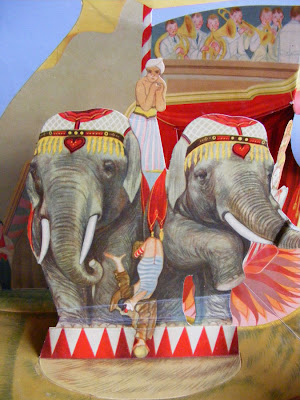
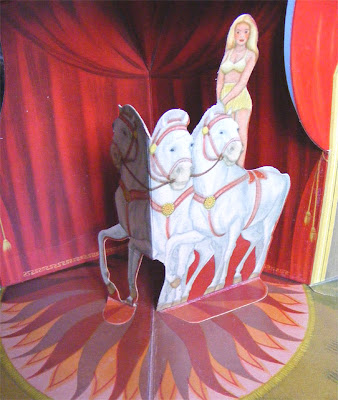
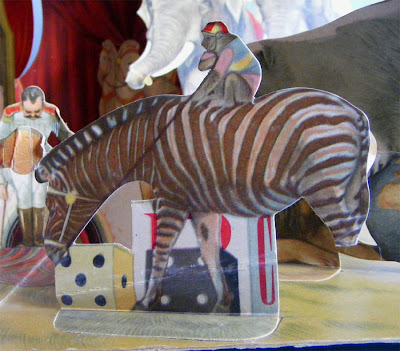
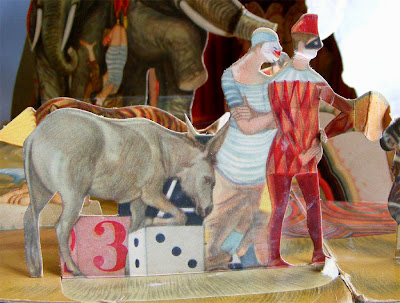
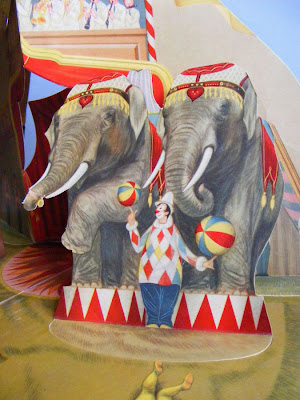
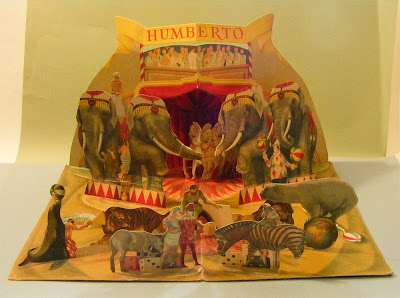
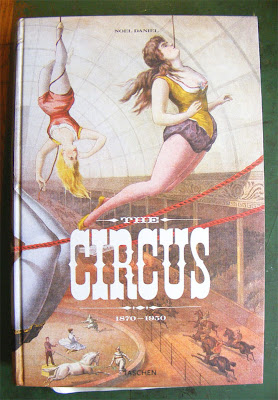
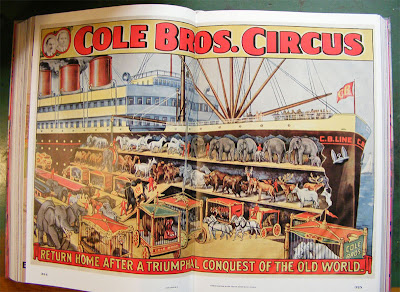
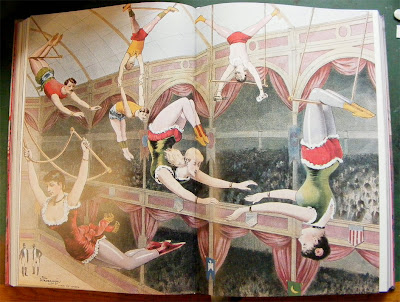

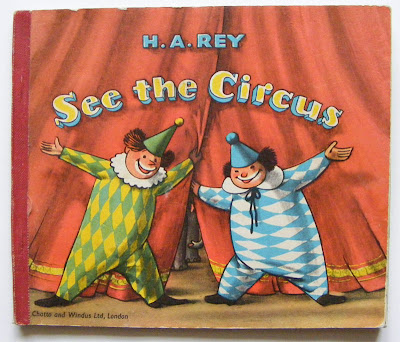

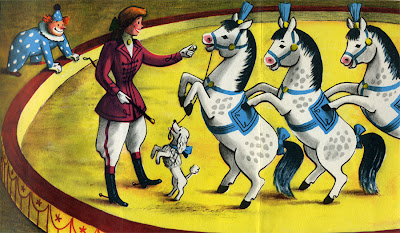

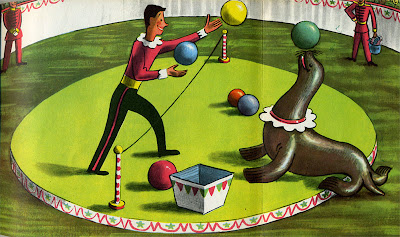
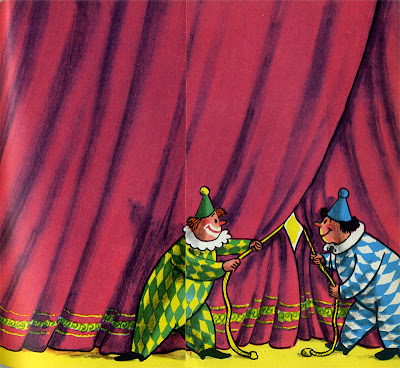
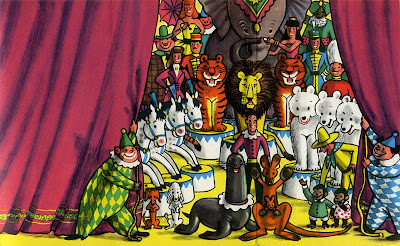
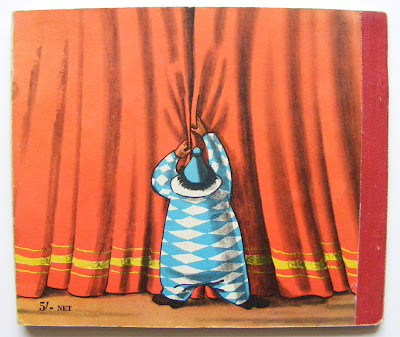
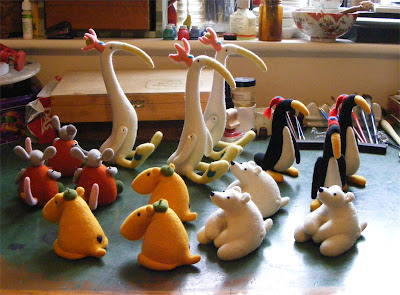
The circus is one of my most favorite places to go and I bet you'd love it! When I read this, I kept thinking, "Ah, Kindred spirits!"
Didn't realise you were into circuses in such a big way Gretel. A fascinating blog entry - loved the books and the great film clip.
Wonderful parade of felted folk at the end.
I used to have something similar to your pop up book as a child... what wonderful memories of those magical times of seemingly endless hours spent looking and looking and looking, spellbound, far beyond the page and way off into the imagination... I wish I could conjure up that innocence again :-)
Don't all the animals look adorable together! Ready to take on the world. I love the circus books, especially the one you received for Christmas.
hello my lovely, I was having a very grey day and boring lunch hour so I thought I'd stop in and found (for the first time, don't worry its just me) your studio cam. And there you were working away, how lovely I thought and it cheered me right up.
Vikki x
I LOVE the pop up book!!!!!!!!!!!!!
and the other and your creatures and the movie! what a delightul post!
Thank you for sharing!
You also welcome to visit my new blog!
Thank you!
Ayelet
I cannot believe you found such a treasure!! What delightful luck.
Personally speaking, I rather deplore the performing animal part of a circus, which usually keeps me away from them...I'd much rather enjoy your felted parade! They are simply adorable.
Since you are a circus fan...have you read the book, Like Water for Elephants?
Oh lovely! And your felted promenade at the end is every bit as magical as the rest.
You've a delight of a menagerie there, PG. Wonderful to think of those creations of yours being adopted by folks who will truly appreciate them.
Circus memory.
Long ago I lived in a small Southern U.S town, and when the circus came to town, there was an actual circus parade, with horse drawn carriage, and horse drawn cages with lions and tigers inside. This parade passed right by my elementary school and we six-year olds were allowed to line up along the sidewalk to see the parade pass by.
Even better, my dad and my grandmother took me to the circus, which was held in a big tent. One ring, with ringmaster. I remember sitting on a bleacher seat and just marveling at the spectacle.
Decades later, I did once attend Ringling Brothers Circus here in New York City at Madison Square Garden. It was by no means as thrilling as seeing that tent-housed circus as a six-year old.
xo
I was fortunate to have a mom that loved to take us to the circus when I was a child. The best one was a traveling circus that came to town when I was 12. We sat in the tent with the smell of the dusty dirt floor while we watched the performances. I even got a red, white, and blue drum majorette baton with a glitter encrusted top. I think that's the last circus I attended and it's the best memory. Thank you for bringing that all back with this post!
Cindy
I attended a three-ring circus in NYC when I was in grade school. I have almost no memories of the circus itself, but more of the subway, the venue, the popcorn and the large, glossy program that I got to bring home.
And for years, we played with a nearly antique, wooden, Fisher-Price circus set. I imagined myself teeny-tiny and participating in the trapeeze adventures that I set up. :-)
I like the idea of the circus but really don't like the real thing - clowns creep me out and I hate seeing majestic animals reduced to performing tricks (what a killjoy - sorry!) However, that cutout circus is fantastic, as is that amazing book. And those little wire mechanical toys are incredible, I just love things like that!
Hello my friend,
I have been away far too long. Hope you are doing well. Your animals are so sweet looking. I can just imagine that they come to life at night and dance around the room.
Love your circus collection. Such vivid colors...Very cheery for sure.
Take good care.
Sending you hugs,
The thing I loved most about the Circus was the glittering, twirling ladies, and of course the horses. Many horses enjoy their work (I know I'm generalising, but Merlin would be great in a circus!)and so that's ok with me. You can keep the clowns though!!!
I love your little parade, and it's great to see them finally finished. Can you take a breather now?
Kim x
Your felted animals are so impressive with their charm and perfect shapes.A job well done, how is your wrist? My rabbits agree with you that performing animals should be in books only, but then I think they think this means behaving animals as well.
I love your circus, and am a little envious .I have been coverting the Tachen circus book myself.But funds will not allow.
I feel very luck to have worked in a circus myself, as a wardrobe mistress on tour in Taiwan (and no I did not agree with the animal side)and I must say it does hold very special memories for me.
I love your animals, they have such wonderful expressions.
ta tata ta ta ta.....
they look like they are getting all "marshalled" for their very own parade.... line up over here everyone..... wheeee....
When I was a kid the circus came to stay for a month in the field behind my house. They arrived at night lorry after lorry hauling mysterious and sometimes noisy loads, and I knelt on the ottoman and gazed out of my mum and dad's bedroom window as they slowly filled the field. The next day I wandered among the lorries and cages and as they began to set up. Watching them raise the big top was amazing. By the end of the month I understood why people ran away with the circus. I longed to join them myself (fire-eater was my first choice, but I would have been equally happy had they offered my the lion-tamer's post). A perfectly wonderful month.
Oh my goodness! Yes! Yes! I love the cardboard circus! And the books! And the video! The music is perfect for it too isn't it? You lucky thing finding such wonderful treasures!x
You always have the most interesting items popping up on here! The menagerie is delightful.
There is a book called 'Water for Elephants' that I think you would love.
Gretel, theres a little award for you on my blog, I think you may like it :)
Kim x
The circus is always so magical, isn't it? A mysterious world. I love your pics and your own animals :)
What a great find for ten pence!
Your little collection of felted animals looks beautiful. What's next on the agenda, a Noah's Ark perhaps?
Your little troupe is wonderful
Pop up books are up there with old paintboxes from childhood.
Your particular felted ménagerie is very funny!
And I agree with you, I do not like performing animals too, it makes me sad.
Your menagerie is very impressive!
I didn't realize that H.A. Rey wrote this book about the circus. He also wrote the "Curious George" books which were my brother's favorites when we were children. (Do you know these books?)
Water for Elephants, which someone else mentioned, might well intrigue you. I have it somewhere; would be happy to mail it to you if you like.
The moscow state circus was on the moor last week, don't think they had any animals though!!
(the moor is the big muddy/grassy thing with rugby posts on it: - it lives at the bottom of our school)
Toby.